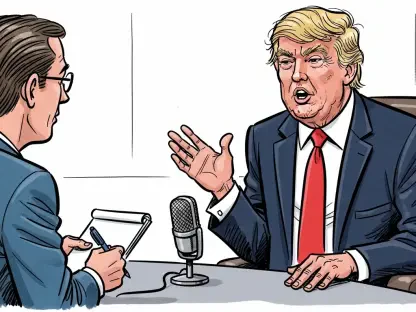The debate over whether the President has the right to unilaterally impound federal funds is a significant constitutional issue that has resurfaced in recent years, particularly during the Trump administration. This discussion centers on the balance of power between Congress and the President, especially regarding the control and allocation of federal spending. The Trump administration’s claims of inherent presidential power to impound funds have reignited this debate, challenging the established legislative framework and constitutional interpretations that have long governed the budgetary process in the United States.
The Trump Administration’s Claims
The Trump administration has argued that the President possesses an inherent power to impound funds, a power they believe was unjustly restricted by the Impoundment Control Act of 1974. This law was enacted in response to President Nixon’s extensive use of impoundments, which led to significant legislative efforts to reassert Congressional control over federal spending. Figures such as Russell Vought and Mark Paoletta have been vocal proponents of this perspective, suggesting that the Act is unconstitutional and that previous Presidents exercised this power without challenge for nearly two centuries.
Supporters of the Trump administration’s stance cite historical instances where past Presidents, including Thomas Jefferson, Ulysses S. Grant, and Franklin D. Roosevelt, used impoundment power. They argue that these examples demonstrate a long-standing acceptance and exercise of this power until the 1970s. The administration’s position is that the President should have the authority to make discretionary decisions about federal spending, particularly in cases where they believe the expenditures are unnecessary or wasteful.
Historical Use of Impoundment
The historical use of impoundment by Presidents is a key point in the debate. Proponents of the Trump administration’s view highlight several instances where Presidents did not fully spend appropriated funds. In 1803, for example, President Thomas Jefferson chose not to use funds appropriated for gunboats, deeming the expenditure unnecessary. Similarly, President Ulysses S. Grant objected to certain infrastructure spending, and President Franklin D. Roosevelt made impoundments during the Great Depression and World War II.
These historical examples are used to argue that the power of impoundment was traditionally accepted and exercised by Presidents. However, critics point out that these instances were often under specific legislative authorizations or within contexts that granted such discretion. The broad rejection of President Nixon’s impoundments in the 1970s reflects a shift towards a more constrained executive power regarding spending, underscoring the importance of legislative oversight and the need for clear boundaries on the President’s authority to impound funds.
Constitutional Arguments Against Unilateral Impoundment
Critics of the Trump administration’s claims argue that the Constitution provides Congress with the exclusive power of the purse, which includes setting both spending ceilings and floors. Legal scholars and judges, including William Rehnquist and Brett Kavanaugh, have refuted the notion that the President has unilateral impoundment authority. They argue that the Constitution clearly gives Congress the power to direct federal spending, and the President must adhere to these directives without discretionary power to refuse spending.
Key Supreme Court rulings, such as Train v. City of New York and Clinton v. City of New York, have reinforced this stance. These rulings have upheld Congressional control over federal spending and rejected the idea that the President can unilaterally refuse to spend appropriated funds. The argument hinges on the U.S. Constitution’s clause that mandates the President to faithfully execute the laws, which opponents of unilateral impoundment interpret to mean that the President must spend the funds as directed by Congress. This interpretation aims to ensure that the executive branch follows the legislative branch’s mandates, maintaining a proper balance of power.
Separation of Powers and Constitutional Fidelity
The debate over impoundment power also touches on the principle of separation of powers. Critics express concerns that allowing the President unilateral impoundment power undermines this fundamental constitutional doctrine. They argue that such power disrupts the balance of powers by granting the executive branch undue control over federal spending, which is constitutionally vested in Congress. This imbalance could lead to an erosion of legislative authority and a significant shift in the federal government’s functional dynamics.
The Impoundment Control Act of 1974 remains a significant legislative measure to ensure Congressional oversight over federal spending. This law provides structured pathways for the President to collaborate with Congress on adjustments to spending but does not allow for unilateral decisions. The prevailing legal consensus, supported by both historical analysis and judicial rulings, is that the President does not have the unilateral authority to impound funds. This consensus aims to preserve the constitutional principles of checks and balances and prevent any overreach by the executive branch.
The Role of Legislation and Judicial Rulings
The Impoundment Control Act was a direct response to President Nixon’s extensive use of impoundments, which angered many Congress members and led to legislative efforts to reassert Congressional control over federal spending. This law remains a critical tool for maintaining the balance of power between the legislative and executive branches. It provides a framework for the President to propose rescissions or deferrals of funds, but these proposals must be approved by Congress, ensuring that any adjustments to federal spending are subject to legislative oversight.
Judicial rulings have consistently supported the constitutionality of the Impoundment Control Act and the principle that the President must adhere to Congressional directives on spending. The Supreme Court’s decisions in Train v. City of New York and Clinton v. City of New York have reinforced the idea that the President cannot unilaterally refuse to spend appropriated funds. These rulings underscore the importance of maintaining the separation of powers and ensuring that the executive branch operates within the constraints set by Congress, thus preserving the integrity of the federal government’s budgetary process.
Conclusion
The discussion over whether the President has the authority to unilaterally impound federal funds has emerged as a significant constitutional issue in recent years, especially during the Trump administration. This debate brings into question the balance of power between Congress and the President, particularly concerning the control and allocation of federal spending. The Trump administration’s assertion of inherent presidential power to impound funds has revitalized this debate, challenging the traditional legislative framework and constitutional interpretations that have long regulated the budgetary process in the United States.
The core issue in this controversy is rooted in the separation of powers established by the United States Constitution. Congress has the “power of the purse,” meaning it is responsible for determining how federal money is spent. On the other hand, the President is tasked with executing these expenditures. The Trump administration’s stance suggested that the President could withhold funds appropriated by Congress, claiming an inherent executive power to do so.
This perspective prompted renewed legal and political scrutiny, as it appeared to stretch the constitutional boundaries of executive authority. Proponents argued that such power was necessary for efficient and responsive government management, while opponents contended it threatened the fundamental principle of checks and balances. This ongoing debate underscores the dynamic nature of constitutional interpretation in American governance.









